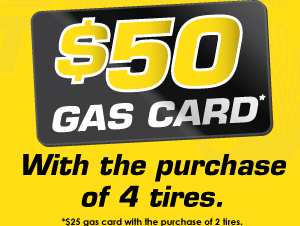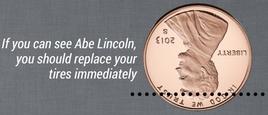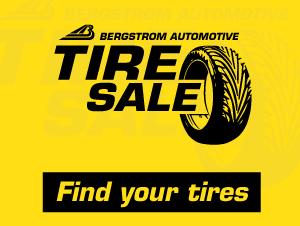Low Price Guarantee
+ $50 Gas Card!
Need new tires? Not sure? We can help today! Call (877) 314-9467.
Your safety is our priority. Whether you buy from Bergstrom or somewhere else, we'll check your tires for free and let you know if you should consider replacing them. We're ready for you if you do decide to replace your tires. We've shopped the competition to assure we have the lowest prices. If you should find - within 30 days of purchasing from Bergstrom - a lower installed price on the identical tire, just let us know and we'll refund the difference.

Maintaining Your Tires

Tire Wear & What Causes It?
There are many factors that can cause tire wear, such as your driving style and tire maintenance habits. Tire replacement is absolutely needed when the tread wear indicators appear. A tire's built-in tread wear indicators look like narrow strips of smooth rubber across the tread and become visible as the tire surface wears.
When to Replace Your Tires?
Tread wear indicators appear when the tires only have 2/32 inch or less of tread remaining. Rubber in tires ages over time. This also applies to the spare tire (if available), even if it is never used. Multiple factors including temperatures, loading conditions, and inflation pressure maintenance affect how fast tires age.
Not sure if you need new tires? Come in for a free inspection. Visit our service center!
Measuring Tread Depth with the Penny Test
The easiest way to check wear on your tire is with a penny. Place a penny upside down between the tire tread. If you can see the top of Lincoln's head, the treads are worn and tire replacement is needed.

Why Is Tire Pressure Important?
Air is a gas, expanding when heated and contracting when cooled. Here in Wisconsin, fall and early winter are especially important times for checking tire pressure. As the ambient temperature falls, tire pressure goes down. A good rule of thumb: with every 10 degrees Fahrenheit of temperature change, tire pressure changes - about 1 psi higher as temperatures rise, lower as they fall.
WHAT HAPPENS IF A TIRE IS UNDERINFLATED? Premature or irregular wear, poor handling, reduced fuel economy and overheating, all of which could lead to a blowout.
WHAT HAPPENS IF A TIRE IS OVERINFLATED? Unusual wear, poor handling, rough ride and greater risk of damage from road hazards.

Weather Affects Your Tires
A good rule of thumb: with every 10 degrees Fahrenheit of temperature change, tire pressure changes about 1 psi - higher psi as temperatures rise, lower psi as temperatures fall.
Tire Rotation
It's a known fact that regular tire rotation extends the life of your tires and improves performance. Tires are rotated to achieve a uniform wear for all tires. Each tire performs different tasks (such as steering in front- versus rear-wheel drive), therefore tires wear at different rates. Tires should be rotated every 7,500 miles to prevent irregular tire wear.
It's important to rotate your tires according to the correct tire-rotation pattern. Doing so will prolong the life of your tires and will reduce the risk of sudden tire failure. Front tires encounter different tasks than the rear tires. And a front-wheel-drive car's tires perform different tasks than those on a rear-wheel-drive car. See the Maintenance Schedule section in your Owner's Manual for additional information about your specific vehicle.

Wheel Alignment & Balance
Proper wheel alignment is key to prolonging the life of your tires. If your vehicle is misaligned, it can cause your tires to wear unevenly, and you may experience handling problems such as pulling or abnormal vibration.
Tires and wheels are aligned and balanced at the factory to provide the longest life and best overall performance. Adjustments to wheel alignment and tire balancing are not necessary on a regular basis. Consider a wheel alignment check if there is unusual tire wear or the vehicle is significantly pulling to one side or the other.
A tire that is out of balance often affects ride quality and can shorten the life of tires, bearings, shocks, and other suspension components. If the vehicle is vibrating when driving on a smooth road, the tires and wheels may need to be rebalanced.

